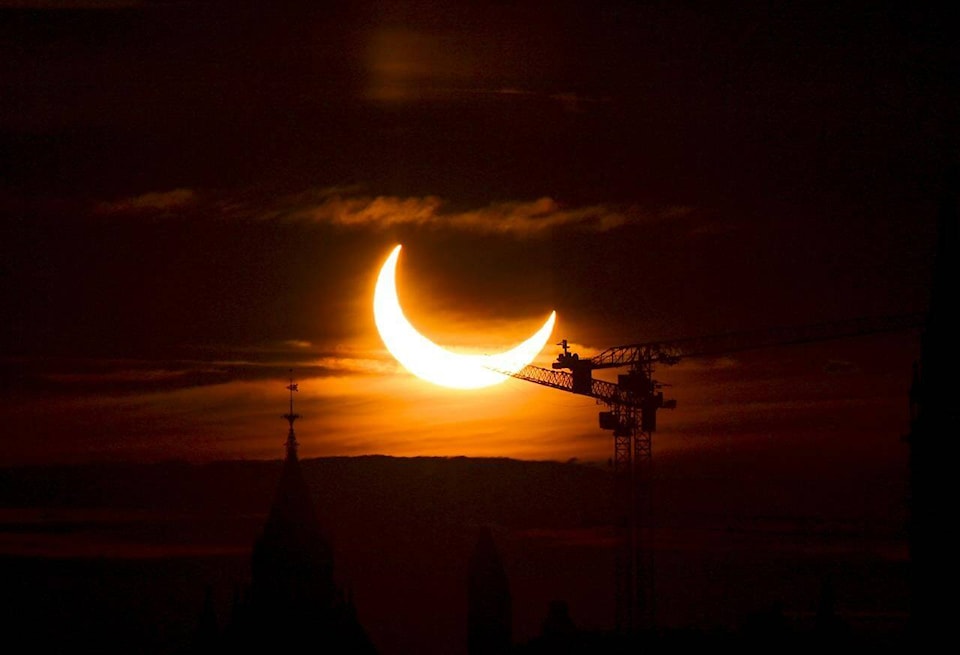Here are the answers to some key questions about the total solar eclipse that will take place on April 8.
What happens during a total solar eclipse?
The moon will be in a direct line between the sun and the Earth, creating a dark, quickly moving shadow on the face of our planet. That particular type of shadow is called an umbra.
For those watching from within the moon’s so-called path of totality, the sun’s rays will be completely blocked, plunging the surrounding landscape into darkness for a short time. Observers outside that path will see a partial eclipse, as the moon will block part of the sun, creating a lighter shadow known as a penumbra.
When and where will it happen?
The main event begins in a remote corner of the South Pacific as the sun rises on April 8. The moon’s shadow will make landfall that morning on Mexico’s west coast, then head to Texas and sweep across much of the United States.
When the penumbra arrives in the southwestern corner of Ontario just before 2 p.m. EDT, a partial eclipse will be followed by a total eclipse starting at about 3:12 p.m., according to Eclipse2024.org. The length of the total eclipse will depend how close you are to the centre of the path of totality, which on April 8 will skirt the southern edge of Lake Erie and southeastern corner of Lake Ontario.
The northern edge of the umbra — the shadow of the total eclipse — will slide across a narrow band of southern Ontario, barely missing Toronto, and then move on to Montreal, arriving for a brief total eclipse around 3:26 p.m. EDT.
After transiting northern Maine, the umbra will enter central New Brunswick just after 4:30 p.m. ADT. About three minutes later, the sky will noticeably darken over western Prince Edward Island.
After clipping the northern tip of Cape Breton, the umbra will head to southwestern corner of Newfoundland, making landfall at 5:09 p.m. local time. It will leave the island’s northeast coast around 5:16 p.m. and sail into the darkening North Atlantic.
How long will the total eclipse last?
At most, four minutes 28 seconds at the centre of the path of total darkness over northern Mexico. As the shadow moves eastward, it will pick up speed. As a result, the duration of totality in the centre of the path will decrease from a maximum of three minutes 38 seconds on the Canadian side of Lake Erie to as little as two minutes 54 seconds in northeastern Newfoundland, according to Eclipse2024.org.
The duration drops off the farther you stray from the path’s centre line.
How fast does the moon’s shadow travel?
The moon’s umbra typically travels at an average speed of 2,400 kilometres per hour, NASA says.
How can I view the eclipse safely?
Eye damage can result if you look directly at the sun, even during a partial eclipse. Protect your eyes with certified eclipse glasses, which can be purchased online. And make sure they are not scratched or torn.
When the moon completely blocks the sun, eclipse glasses can be removed to observe the sun’s corona — the wispy tendrils of light that show the outer limits of the sun’s energetic atmosphere. But as the moon moves away and the partial eclipse resumes, eye protection is a must.
How big is the moon’s shadow?
The moon is about 3,400 kilometres in diameter, but its shadow tapers as it reaches the Earth. During next month’s total eclipse, the path of the umbra will be about 185 kilometres wide. The width varies with each eclipse.
What should I watch for when the total eclipse arrives?
Assuming there is little cloud cover, the sun’s rays will disappear into twilight, glimmering stars and planets will appear and the horizon will glow orange like at sunset. As well, the temperature will drop and nearby animals may act strangely, experts say.
Be sure to watch for the emergence of Bailey’s beads and the diamond ring effect, cosmic phenomena that appear to the naked eye only during a total eclipse.
Are total solar eclipses rare?
They appear once or twice every year somewhere on the planet, according to NASA. Most locations typically wait between 400 and 1,000 years for a repeat performance.
Nova Scotia, however, was visited by total solar eclipses in 1970 and again in 1972. And next month’s eclipse will also track across the northern tip of Cape Breton.
Since 1963, Canadians have witnessed five total solar eclipses, though the one in 2008 tracked across the upper reaches of the Arctic.
When is the next total solar eclipse?
In 2026, a total solar eclipse will glide across northern Greenland, Iceland and Spain.
The next total solar eclipse in North America will arrive on March 30, 2033, but only in Alaska. For those living farther south, you’ll have to wait until 2044, when the moon’s shadow will sweep across Western Canada, Montana and North Dakota.
READ ALSO: It’s time for the longest lunar eclipse of the century
